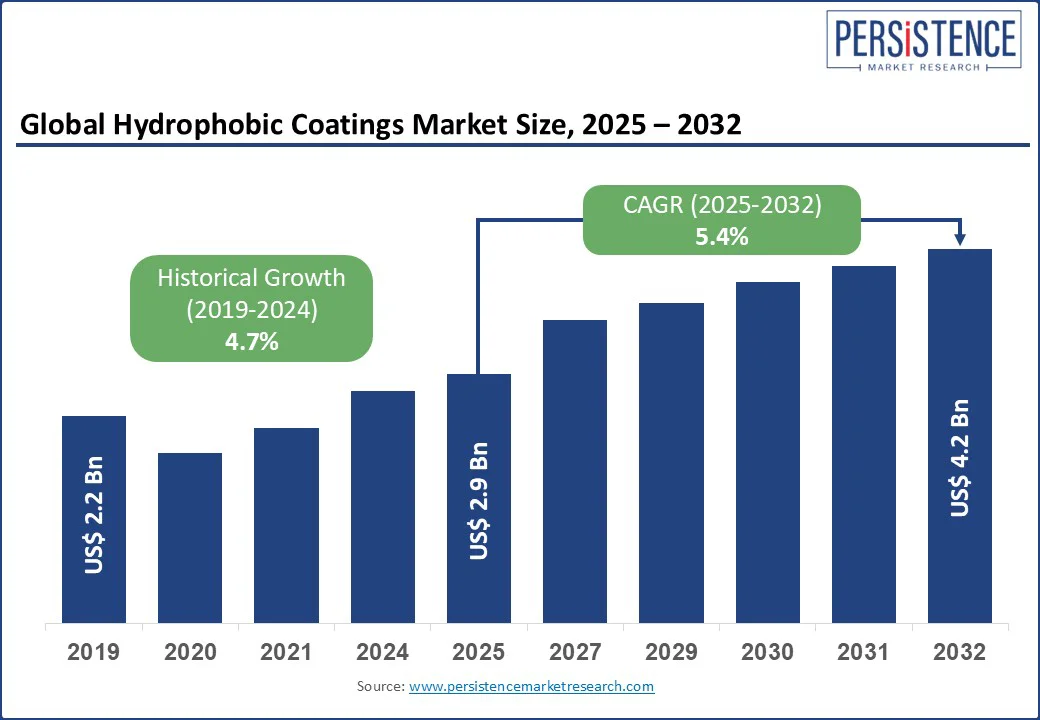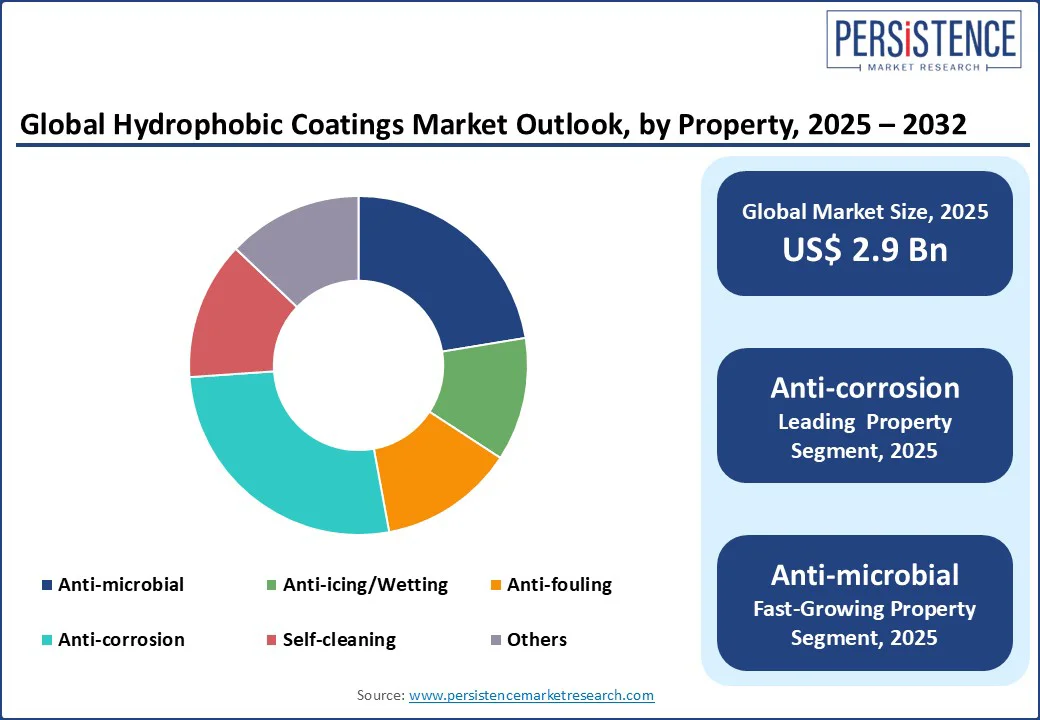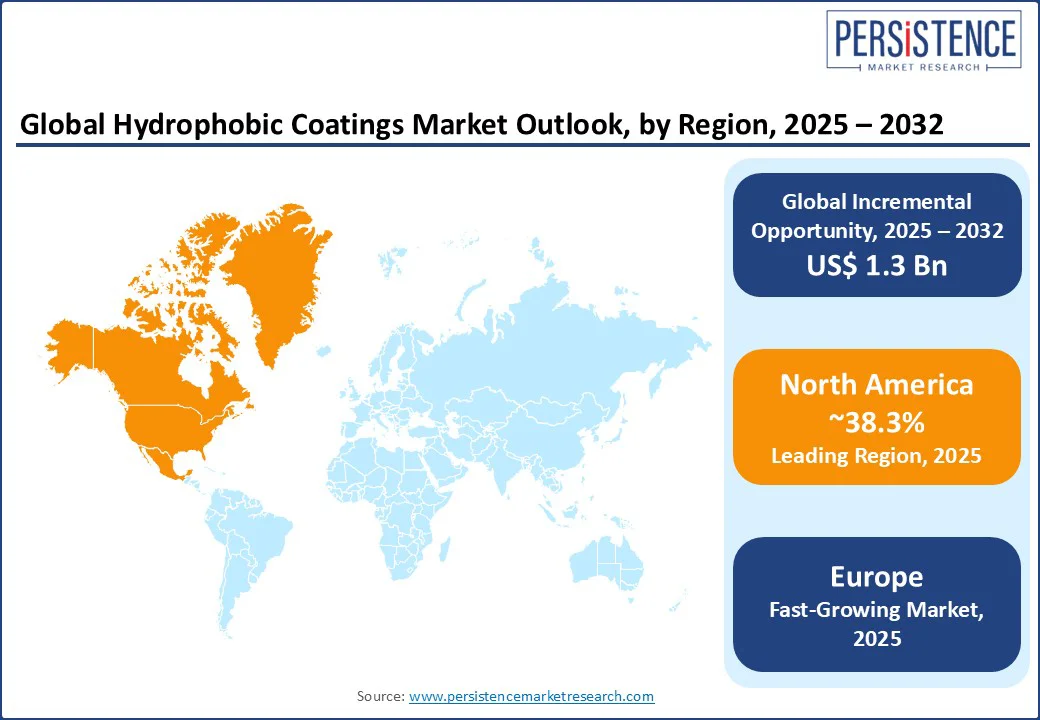ID: PMRREP16927| 189 Pages | 23 Aug 2025 | Format: PDF, Excel, PPT* | Chemicals and Materials

The hydrophobic coatings market size is expected to be valued at US$2.9 billion in 2025 and is projected to reach US$4.2 billion in 2032, growing at a CAGR of 5.4% during the forecast period of 2025 -2032.
The growth of the hydrophobic coatings industry is driven by rising demand for high-performance, safety, and sustainability across a wide range of industries. By creating surfaces that resist moisture, dirt, and microbial growth, these coatings enable manufacturers to extend product lifecycles, reduce maintenance costs, and meet stringent regulatory standards.
Key Industry Highlights

|
Global Market Attribute |
Key Insights |
|
Hydrophobic Coatings Market Size (2025E) |
US$2.9 Bn |
|
Market Value Forecast (2032F) |
US$4.2 Bn |
|
Projected Growth (CAGR 2025 to 2032) |
5.4% |
|
Historical Market Growth (CAGR 2019 to 2024) |
4.7% |
The rising demand for consumer electronics is driving interest in hydrophobic coatings, as modern devices are expected to withstand exposure to moisture, sweat, and accidental spills. Consumers now prioritize durability and water resistance as key purchase factors with smartphones, wearables, and earbuds being used in daily outdoor and fitness settings.
Companies such as Apple and Samsung already rely on hydrophobic nanocoatings to protect internal circuits and connectors. They help ensure functionality even when devices are exposed to rain or high humidity.
Beyond protection, hydrophobic coatings are also improving the usability of next-generation devices. For example, smartwatch makers such as Garmin and Fitbit use these coatings to safeguard sensors that track heart rate and oxygen levels. These help in ensuring accuracy even when the devices come into contact with sweat or water during workouts.
In the gaming industry, VR headsets are starting to feature hydrophobic coatings on their lenses to prevent fogging, thereby further improving visual clarity and user comfort during extended sessions.
Potential environmental concerns are hampering the wide adoption of hydrophobic coatings, as several formulations rely on fluorinated compounds. These are under scrutiny for their persistence in ecosystems. Known as per- and polyfluoroalkyl substances (PFAS) or forever chemicals, these substances have been linked to water contamination issues in Europe and North America, prompting regulators to restrict their use. The European Chemicals Agency (ECHA) has proposed strict limitations on PFAS-based coatings, compelling companies to either reformulate their products or face restricted market access.
Limited durability is another barrier as various hydrophobic coatings degrade under mechanical abrasion, UV exposure, or frequent cleaning. It is a challenge in construction and automotive applications, where surfaces are constantly exposed to environmental stress.
High production costs further restrict growth potential, primarily in price-sensitive industries such as textiles. Nanostructured coatings that deliver premium hydrophobic performance require unique manufacturing processes and specialized raw materials. This increases their costs, causing small companies to opt for less effective and more affordable coatings to remain competitive.
Digital printing technology is creating new opportunities for hydrophobic coatings by enabling precise and customized application methods that were not possible with traditional spraying techniques. Digital printing enables coatings to be deposited in controlled patterns and thicknesses, making it ideal for complex surfaces such as those found in microelectronics, medical devices, and automotive sensors.
For instance, researchers in South Korea recently demonstrated digitally printed hydrophobic nanolayers on flexible electronic circuits. They ensured both moisture protection and signal integrity without adding bulk. This type of precision is opening new markets where coatings must be applied selectively rather than as a uniform layer.
The technology also supports rapid prototyping and on-demand customization, which is attractive in consumer electronics and healthcare. Smartphone manufacturers in China have begun experimenting with digital printing to apply ultra-thin hydrophobic coatings on foldable displays.
In healthcare, various Europe-based start-ups are testing printed antimicrobial hydrophobic coatings on surgical instruments. They are enabling hospitals to utilize protective solutions quickly while maintaining sterilization standards.
By property, the market is divided into anti-microbial, anti-icing/wetting, anti-fouling, anti-corrosion, self-cleaning, and others. Among these, anti-corrosion coatings are predicted to hold around 26.8% of the hydrophobic coatings market share in 2025, as they address two key issues simultaneously: protection against moisture and resistance to surface degradation.
Traditional coatings tend to slow down rusting, but hydrophobic variants actively repel water, preventing it from settling on metal surfaces. This makes them essential in industries where metal components are exposed to harsh weather conditions, high humidity, or chemical environments.
Hydrophobic coatings with antimicrobial properties are gaining traction because they help prevent contamination and improve surface longevity. Hydrophobicity makes it difficult for liquids and organic matter to adhere, while the antimicrobial layer ensures that harmful pathogens do not survive on surfaces.
This dual advantage is particularly important in hospitals, where high-touch areas, such as surgical tools, bed rails, and medical devices, require resistance to microbial growth and repeated exposure to cleaning agents.
In terms of application, the market is segmented into aerospace, automotive, construction, medical, optical, and other industries. Out of these, the automotive sector is poised to account for nearly a 25.4% share in 2025, as a modern fleet of vehicles is expected to deliver not only performance but also durability in diverse environmental conditions.
Hydrophobic coatings create a protective barrier that repels water, dirt, and salts, which are common causes of surface degradation in cars. This lowers the frequency of cleaning and minimizes corrosion in exposed areas, including underbodies, wheel arches, and door panels.
Construction is a key application area as the industry constantly battles moisture-related degradation, which tends to hamper the structural integrity of buildings and infrastructure. Hydrophobic coatings help create surfaces that actively repel water, thereby preventing capillary absorption in concrete, bricks, and stones.
This is essential in regions with high rainfall or coastal exposure, where water ingress can cause cracks, freeze-thaw damage, and corrosion of embedded steel reinforcements.

In 2025, North America will likely account for approximately 38.3% of share due to rising focus on novel manufacturing and high-performance materials. The automotive industry has been one of the most prominent adopters.
Companies such as General Motors and Ford have been experimenting with hydrophobic and oleophobic coatings for exterior protection and sensor functionality in electric and autonomous vehicles. This push is linked to the rise of EV production hubs in the U.S. and Canada, where moisture protection for battery packs and charging ports has become an important design priority.
Recent patents filed by Tesla also point to the use of such coatings to maintain camera clarity for driver-assist systems, signaling a shift from cosmetic to highly functional applications. The U.S. hydrophobic coatings market is witnessing a high demand from the construction industry, mainly in infrastructure renewal projects.
Hydrophobic coatings are being explored as a cost-effective solution to extend the life of concrete and steel structures. This is because of increasing investments by the U.S. federal government in repairing bridges, highways, and tunnels under the Infrastructure Investment and Jobs Act.
In Europe, the market is being propelled by the region’s strict sustainability mandates and advanced engineering standards. The region’s focus on extending the lifecycle of infrastructure has made these coatings ideal for large-scale construction projects. Germany and the Netherlands are applying hydrophobic nanocoatings to bridges, tunnels, and public buildings to counter long-term moisture penetration. It is evident in areas prone to flooding and freeze-thaw cycles.
The automotive industry in Europe is also augmenting adoption, but with a rising focus on sustainability and performance. Premium carmakers, including Audi and BMW, are experimenting with hydrophobic coatings for paint protection, EV battery housing, and sensor maintenance in autonomous driving systems.
These coatings are being designed to be solvent-free or water-based, which helps meet the EU’s stringent REACH regulations on chemical safety. Hospitals are also implementing antimicrobial hydrophobic coatings on high-touch surfaces, a measure strengthened by new infection control protocols after COVID-19.
Ongoing industrial growth and unique climatic challenges are influencing the market in the Asia Pacific. High humidity, heavy monsoons, and coastal exposure in India, Indonesia, and Thailand create constant risks of water damage and corrosion. This raises demand for such coatings in the construction and infrastructure sectors.
India’s Smart Cities Mission, for instance, has included trials of hydrophobic coatings on concrete flyovers and metro rail stations to reduce water seepage during monsoons. In Japan, coastal infrastructure projects are applying these coatings to steel bridges to counter salt-induced corrosion from typhoons and sea spray.
The automotive industry is another key consumer in the Asia Pacific. With increasing EV manufacturing, hydrophobic coatings are being applied to protect sensitive components such as battery enclosures and charging ports. BYD and Hyundai have been testing such coatings on EV models to ensure safety in humid and flood-prone markets. At the same time, Japan-based automakers are focusing on hydrophobic-coated LiDAR and camera systems to improve the performance of driver-assist features during heavy rains.

The hydrophobic coatings market consists of various established chemical giants, niche nanotechnology firms, and start-ups focusing on sustainable solutions. Large multinational companies dominate with extensive product portfolios and research pipelines, often targeting automotive and construction applications.
Their position enables them to integrate hydrophobic properties into multifunctional coatings. They are focused on creating blends that combine corrosion resistance, UV stability, and antimicrobial features. Small firms and university spin-offs are coming up with highly specialized nanocoatings, including eco-friendly water-based formulations, to comply with strict norms on volatile organic compounds.
The hydrophobic coatings market is projected to reach US$ 2.9 Bn in 2025.
Rising demand for durable surfaces and increasing use of EVs are the key market drivers.
The hydrophobic coatings market is poised to witness a CAGR of 5.4% from 2025 to 2032.
Development of abrasion-resistant formulations and growing smart city projects are the key market opportunities.
BASF SE, Akzo Nobel N.V., and Nippon Paint Private Limited are a few key market players.
|
Report Attribute |
Details |
|
Historical Data/Actuals |
2019 - 2024 |
|
Forecast Period |
2025 - 2032 |
|
Market Analysis |
Value: US$ Bn/Mn, Volume: As Applicable |
|
Geographical Coverage |
|
|
Segmental Coverage |
|
|
Competitive Analysis |
|
|
Report Highlights |
|
|
Customization and Pricing |
Available upon request |
By Property
By Substrate Type
By Application
By Region
Delivery Timelines
For more information on this report and its delivery timelines please get in touch with our sales team.
About Author